Engaged Anthropology Grant: Nancy Moinde
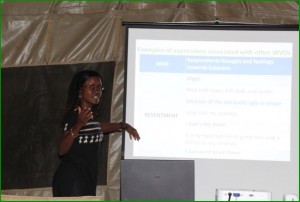
While a doctoral student at Rutgers University Nancy Moinde received a Dissertation Fieldwork Grant in 2008 to aid research on “Effects of Land Use Practices on the Socioecology of Olive Baboons,” supervised by Dr. Ryne Arthur Palombit. In 2015 Dr. Moinde received an Engaged Anthropology Grant to aid engaged activities on “The Human-baboon Interface: Implications for Wildlife Conservation and Management in Laikipia County, Kenya”.
In April of 2015 I returned to my fieldsite to carry out my engagement project with the aim of the project being to inform on values that would promote tolerance and foster practices to alleviate conflict towards baboons and potentially other wildlife in Laikipia.
Projects Activities
Local baboon management strategies based on research recommendations
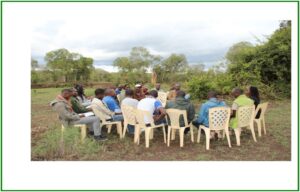
Both the Laikipia Wildlife Forum, (LWF) and Keyna Wildlife Services, (KWS) work closely together in matters pertaining to wildlife management conservation and policy in Laikipia County. The LWF is a dynamic membership-driven organization of small holders, community groups, and conservancy stakeholders focusing on integrated natural resources management. The KWS is a parastatal – which is the main arm of the government that deals with national wildlife management and conservation issues in unprotected areas. I disseminated baboon management strategic recommendations to both these organizations as they significantly contribute to implementing wildlife management conservation policy as explained in more detail below.
Dissemination of findings through various established LWF Environmental Education and Eco Literacy Program (EEELP) network structures: The LWF EEELP’s main goal is to disseminate information through formal and informal education programs in Laikipia. Using the established LWF EEELP network, I was able to more efficiently disseminate my research findings through their various networks and membership. Another dissemination strategy the EEELP platform used to inform the public was through online blogs and newsletters. I also trained Conservancy wildlife guides on human-wildlife conflict management as part of the larger objectives of the Laikipia Wildlife Forum Strategic plan 2010-2015.
Publication of research findings using LWF EEELP network channels: I published chapter 4 of my dissertation through the well-circulated local Laikipia Wildlife Forum Newsletter, which is issued on a quarterly basis annually.
Secretariat of the National Primate Conservation Task Force (NPCTF)
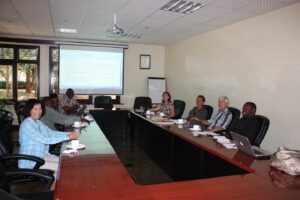
The NPCTF is a forum where primatologists discuss matters pertaining to primate conservation and management strategies: Information is gathered from various ongoing research projects. Some of the primatologist in the NPCTF, such as, Prof Shirley Strum (California – San Diego), Dr. Tom Butynski and Dr. Yvonne de Jong (Eastern Africa Primate Diversity and Conservation Programme) have ongoing research sites and activities in Laikipia and are all members of LWF and the National Primate Task Force (NPCTF).
The goal of the NPCTF is to develop national strategic primate management and conservation guidelines with KWS as the Chair of all national wildlife species Task Forces. The KWS newsletter summarizes the objectives of the NPCTF since its inception in 2013.
Promoting mutualistic values by coordinating students “walking with baboons” onsite visits in Laikipia County
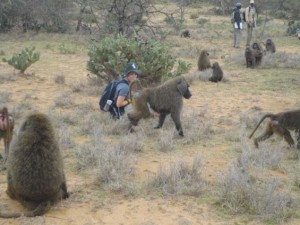
I taught students about the olive baboon’s social systems, feeding ecology and the local people’s values towards baboons in a group of habituated baboons where “baboon-tourism” is undertaken in Il Polei in Laikipia County. Topics also included the cost and benefits of living “with baboons in relation to “baboon-tourism” as a land use ecotourism endeavor. I also arranged for students from different academic institutions to attend the baboon research project near Twala to learn more about baboon social and feeding behavior from an evolutionary perspective and inform on local people’s values in response to “baboon-tourism” as a viable land use option in Laikipia County.
The Primatology, Wildlife Ecology and Conservation Field School (PWEC)
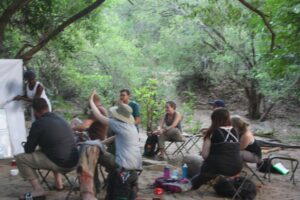
The PWEC field school offers undergraduate and graduate students from different American and Kenyan universities a unique opportunity to learn about wildlife biodiversity across a range of diverse East African habitats. As the Field Director of the PWEC field school, I contributed to the formulation of an academic syllabus that exposed students to various conservation problems, current debates, and emerging innovative solutions that are contextually and culturally different than any they would find elsewhere. The guest speakers were selected from a wide range of conservation interest groups and included wildlife ecologists and conservationists. Diverse guest speakers whose wildlife and community based research activities in Laikipia also participated and contributed immensely to interactive discussions and constructive debate on different dimensions of wildlife conservation strategies.
The PWEC field school syllabus outlines the diversity of conservation management themes from various national and international wildlife ecologist and conservationists whose research is based in Laikipia. Note that the syllabus also includes presentation and discussions I gave to students on my PhD findings on baboon socioecology and interactions with humans in Laikipia as part of the goal of this project.
International Primatological Symposium and Conference Presentation – January 2016, Held in Nanyuki, Kenya
I participated in a primatologist symposium that discussed issues related to human-non-human primate interactions. Topics on the symposium included human exploitation of animals as resources, their symbolic significance to humans and varied culturally constructed values and agendas around wildlife from different parts of the globe.
Symposium with Primate ecologist and conservationist: The topic under discussion was entitled,
“People-primate interactions: understanding ‘conflicts’ to facilitate coexistence.”
Participants: Kate Hill (Oxford Brookes University), Nancy Moinde (Department of Conservation Biology, Institute of Primate Research), Joana Sousa (Institute of Mediterranean Agricultural and Environmental Sciences, University of Evora), Matthew McLennan (Anthropology Centre for Conservation, Environment and Development, Oxford Brookes University), Amanda Webber (Bristol Zoological Society).
I also presented the results of my PhD thesis at the Pathways conference. The presentation was entitled “The effects of land use practices on human-baboon (Papio hamadryas anubis) interactions in Laikipia County, Kenya.”